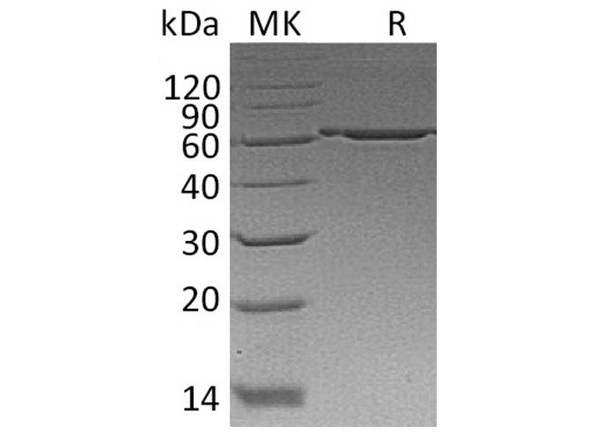Anti-P4HB Antibody (CAB19239)
- SKU:
- CAB19239
- Product Type:
- Antibody
- Antibody Type:
- Monoclonal Antibody
- Reactivity:
- Human
- Reactivity:
- Mouse
- Reactivity:
- Rat
- Host Species:
- Rabbit
- Isotype:
- IgG
- Synonyms:
- P4HB
- Synonyms:
- CLCRP1
- Synonyms:
- DSI
- Synonyms:
- ERBA2L
- Synonyms:
- GIT
- Synonyms:
- P4Hbeta
- Synonyms:
- PDI
- Synonyms:
- PDIA1
- Synonyms:
- PHDB
- Synonyms:
- PO4DB
- Synonyms:
- PO4HB
- Synonyms:
- PROHB
- Synonyms:
- protein disulfide-isomerase
- Research Area:
- Cell Biology
Description
| Product Name: | P4HB Rabbit mAb |
| Product Code: | CAB19239 |
| Size: | 20uL, 50uL, 100uL |
| Synonyms: | P4HB, CLCRP1, DSI, ERBA2L, GIT, P4Hbeta, PDI, PDIA1, PHDB, PO4DB, PO4HB, PROHB, protein disulfide-isomerase |
| Applications: | WB, IHC |
| Reactivity: | Human, Mouse, Rat |
| Host Species: | Rabbit |
| Immunogen: | Recombinant protein of human P4HB. |
| Applications: | WB, IHC |
| Recommended Dilutions: | WB 1:500 - 1:2000 IHC 1:50 - 1:200 |
| Reactivity: | Human, Mouse, Rat |
| Positive Samples: | HepG2, NIH/3T3, Mouse liver, Mouse testis, Rat liver |
| Immunogen: | Recombinant protein of human P4HB. |
| Purification Method: | Affinity purification |
| Storage: | Store at -20°C. Avoid freeze / thaw cycles. Buffer: PBS with 0.02% sodium azide, 50% glycerol, pH7.3. |
| Isotype: | IgG |
| Sequence: | Email for sequence |
| Gene ID: | 5034 |
| Uniprot: | P07237 |
| Cellular Location: | Cell membrane, Endoplasmic reticulum, Endoplasmic reticulum lumen, Melanosome, Peripheral membrane protein |
| Calculated MW: | 57kDa |
| Observed MW: | 57KDa |
| UniProt Protein Function: | PDIA1: This multifunctional protein catalyzes the formation, breakage and rearrangement of disulfide bonds. At the cell surface, seems to act as a reductase that cleaves disulfide bonds of proteins attached to the cell. May therefore cause structural modifications of exofacial proteins. Inside the cell, seems to form/rearrange disulfide bonds of nascent proteins. At high concentrations, functions as a chaperone that inhibits aggregation of misfolded proteins. At low concentrations, facilitates aggregation (anti-chaperone activity). May be involved with other chaperones in the structural modification of the TG precursor in hormone biogenesis. Also acts a structural subunit of various enzymes such as prolyl 4-hydroxylase and microsomal triacylglycerol transfer protein MTTP. Homodimer. Monomers and homotetramers may also occur. Also constitutes the structural subunit of prolyl 4-hydroxylase and of the microsomal triacylglycerol transfer protein MTTP in mammalian cells. Stabilizes both enzymes and retain them in the ER without contributing to the catalytic activity. Binds UBQLN1. Binds to CD4, and upon HIV-1 binding to the cell membrane, is part of a P4HB/PDI-CD4-CXCR4-gp120 complex. Belongs to the protein disulfide isomerase family. |
| UniProt Protein Details: | Protein type:EC 5.3.4.1; Nuclear receptor co-regulator; Isomerase; Oxidoreductase; Endoplasmic reticulum Chromosomal Location of Human Ortholog: 17q25 Cellular Component: focal adhesion; endoplasmic reticulum lumen; endoplasmic reticulum; ER-Golgi intermediate compartment; plasma membrane; extracellular region; melanosome Molecular Function:protein binding; enzyme binding; procollagen-proline 4-dioxygenase activity; protein heterodimerization activity; endopeptidase activity; protein disulfide isomerase activity Biological Process: response to reactive oxygen species; extracellular matrix organization and biogenesis; protein folding; cell redox homeostasis; lipoprotein metabolic process; peptidyl-proline hydroxylation to 4-hydroxy-L-proline; proteolysis Disease: Cole-carpenter Syndrome 1 |
| NCBI Summary: | This gene encodes the beta subunit of prolyl 4-hydroxylase, a highly abundant multifunctional enzyme that belongs to the protein disulfide isomerase family. When present as a tetramer consisting of two alpha and two beta subunits, this enzyme is involved in hydroxylation of prolyl residues in preprocollagen. This enzyme is also a disulfide isomerase containing two thioredoxin domains that catalyze the formation, breakage and rearrangement of disulfide bonds. Other known functions include its ability to act as a chaperone that inhibits aggregation of misfolded proteins in a concentration-dependent manner, its ability to bind thyroid hormone, its role in both the influx and efflux of S-nitrosothiol-bound nitric oxide, and its function as a subunit of the microsomal triglyceride transfer protein complex. [provided by RefSeq, Jul 2008] |
| UniProt Code: | P07237 |
| NCBI GenInfo Identifier: | 2507460 |
| NCBI Gene ID: | 5034 |
| NCBI Accession: | P07237.3 |
| UniProt Secondary Accession: | P07237,P30037, P32079, Q15205, Q6LDE5, B2RDQ2, |
| UniProt Related Accession: | P07237 |
| Molecular Weight: | 57,116 Da |
| NCBI Full Name: | Protein disulfide-isomerase |
| NCBI Synonym Full Names: | prolyl 4-hydroxylase, beta polypeptide |
| NCBI Official Symbol: | P4HB |
| NCBI Official Synonym Symbols: | DSI; GIT; PDI; PHDB; PDIA1; PO4DB; PO4HB; PROHB; ERBA2L; P4Hbeta |
| NCBI Protein Information: | protein disulfide-isomerase; p55; protocollagen hydroxylase; prolyl 4-hydroxylase subunit beta; collagen prolyl 4-hydroxylase beta; thyroid hormone-binding protein p55; glutathione-insulin transhydrogenase; cellular thyroid hormone-binding protein; protein disulfide isomerase-associated 1; protein disulfide isomerase/oxidoreductase; protein disulfide isomerase family A, member 1; procollagen-proline, 2-oxoglutarate 4-dioxygenase (proline 4-hydroxylase), beta polypeptide |
| UniProt Protein Name: | Protein disulfide-isomerase |
| UniProt Synonym Protein Names: | Cellular thyroid hormone-binding protein; Prolyl 4-hydroxylase subunit beta; p55 |
| UniProt Gene Name: | P4HB |
| UniProt Entry Name: | PDIA1_HUMAN |






